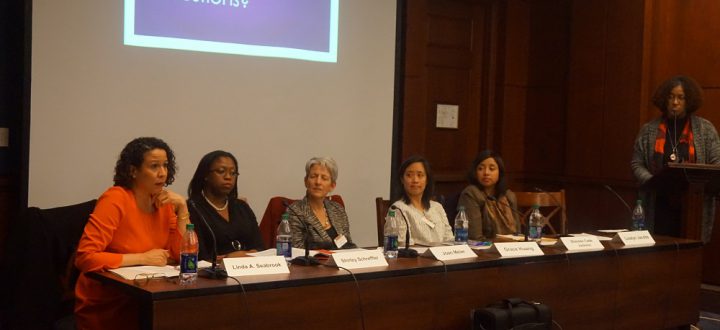TOOLS AND TIPS FOR IDENTIFYING WOMEN WHO ARE BEING ABUSED
Women who are experiencing abuse may not feel comfortable openly disclosing this information, for a variety of reasons. This is why health care providers must have good tools for detecting and assessing abuse.
- What are some indicators that a woman is being abused?
- When should I ask about abuse?
- A Doctor’s Recommendations on Building Trust for the Disclosure of Violence
- What should providers ask?
- A Social Worker’s Recommendations on How to “Find out What’s Really Going on”
- Midwives’ Tips on Detecting Abuse in Rural Indigenous Communities
- Materials on detecting abuse
What are some indicators that a woman is being abused?
- Secrecy or obvious discomfort when interviewed about relationship
- Unexplained injuries or injuries inconsistent with the history given
- Delay between an injury and seeking medical treatment
- Physical injury during pregnancy, especially on the breasts and abdomen
- An unusually high number of visits to health care providers
- High number of STI’s, pregnancies, miscarriages, and abortions
- Repeat vaginal and urinary tract infections.
When should I ask about abuse?
- Orally as part of a face-to-face health care encounter
- As part of a routine health questionnaire
- Using direct and nonjudgmental language that is culturally/linguistically appropriate
- In private: no friends, relatives (except children under 3) or caregivers should be present
- Confidentially: prior to inquiry, patients should be informed of any reporting requirements or other limits to provider/patient confidentiality
- Assisted, if needed, by interpreters who have been trained to ask about abuse and have been trained on maintaining confidentiality, especially in small and rural communities.
What should providers ask?
Health care providers can develop their own style of asking questions, and can adapt to the particular cultural patterns of their communities. It is important to adapt your assessment questions and approach in order to be respectful to individual patients. Listen to patients, pay attention to words that are used in different cultural settings and integrate those into assessment questions. These are some examples of how to raise the issue of family violence and ask questions about it.
1. After you have established a rapport with the patient, raise the issue:
- “Because violence is so common in many people’s lives, I’ve begun to ask all my patients about it”
- “I am concerned that your symptoms may have been caused by someone hurting you”
2. If it feels appropriate, ask directly about violence:
- “Are you in a relationship with a person who physically hurts or threatens you?”
- “Has your partner or ex-partner ever hit you or physically hurt you?”
- “Do you ever feel afraid of your partner? Do you feel you are in danger?”
- “Has your partner ever forced you to have sex when you didn’t want to? Has your partner ever refused to practice safe sex?”
3. If the patient discloses violence, assess the risk:
- “Are you in immediate danger?”
- “Is your partner at the health facility now?”
- “Do you want to (or have to) go home with your partner?”
- “Do you have somewhere safe to go?”
4. Assess the patterns of abuse:
- “How long has the violence been going on?”
- “Have you ever been hospitalized because of the abuse?”
- “Has your partner forced you to have sex, hurt you sexually, or forced you into sexual acts that made you uncomfortable?”
5. Provide validation and support:
- Listen non-judgmentally
- “I am concerned for your safety (and the safety of your children)”
- “You are not alone and help is available”
- “You don’t deserve the abuse and it is not your fault”
6. If a patient says “no”:
- Respect her/his response
- Let the patient know that you are available should the situation ever change
- Assess again at previously recommended intervals
- If patient says “no” but you believe s/he may be at risk, discuss the specific risk factors and offer information and resources in exam and waiting rooms, or bathrooms.
Materials on detecting abuse:
- Assessment Guide (English)
- Assessment Guide (Spanish)
- Desk Calendar (Spanish) for health care providers, includes tips on detecting and assessing abuse. Developed by Grupo de Estudios sobre la Mujer Rosario Castellanos.
A Doctor’s Recommendations on Building Trust for the Disclosure of Violence

Dr. Rufina Gonzalez Reyes believes that building trust between healthcare providers and patients is essential. In her extensive experience working in rural indigenous communities in Oaxaca, she has worked hard to develop the trust that will allow women to disclose abuse to her. Her recommendations for other health care providers include:
- Be patient and recognize that developing relationships takes time.
- Try to downplay the divide between yourself as “doctor” and the women you’re working with.
- Visit women in their homes, eat their food, accept and use gifts that are offered to you, dress similarly to the way they dress. Try to enter into the culture and share it.
- Try out traditional healing methods and demonstrate openness to them. Experience them yourself in order to understand the reality of the women you’re working with.
- Listen to comments within the community and try to understand community dynamics.
- Make sure women know they’re not alone and make them feel that you see them as a friend and someone who’s just like them. Click here to listen to Dr. Rufina talking about building trust and detecting violence, in her own words.
A Social Worker’s Recommendations on How to “Find out What’s Really Going on”
Margarita Martinez Aguilar, the social worker at Tlacolula Hospital in Tlacolula de Matamoros, Oaxaca, prides herself on her ability to ask good questions, and says that doctors and others at the hospital send patients to her when they are trying to figure out “what’s really going on.” Margarita’s suggestions for other healthcare providers include:
- Do not make assumptions about what a woman is going through. Ask questions to find out what’s going on.
- Recognize that psychological and verbal abuse is common, and that violence may be present even if there is no physical sign. Ask women how they feel at home.
- Ask questions about family structure, health conditions, family economics, etc. These questions can give you a sense of the family dynamic without asking directly about abuse.
- When women present with physical problems, ask them what they think is causing these problems.
- Don’t be afraid to delve into a difficult situation. Don’t be afraid that the abuser will retaliate against you. Remember that asking good questions is part of your job, and follow your own sense of ethics to serve people responsibly.
- Have empathy, and allow this empathy to come through in the tone of voice and the approach you use.
- If a woman discloses to you, ask follow-up questions so that she knows you are concerned and want her to feel safe telling you more.
- Make sure you follow up on the case. Schedule follow-up meetings with the patient. Ask her doctors what they are doing to follow-up on her case.
- Make sure that you yourself are feeling well and strong so that you will be able to help other people.
Click here to listen to Margarita talking about how she asks good questions to detect abuse, in her own voice.
Midwives’ Tips on Detecting Abuse in Rural Indigenous Communities
Marcelina, a traditional Tsotsil midwives in rural Chiapas, has developed her own techniques for detecting and assessing abuse. These are based more on intuition and a deep understanding of the dynamics of her community, rather than on following written checklists. They are examples of how these basic principles of detection can be applied to a specific community. To detect violence against her pregnant patients, Marcelina takes the following steps:
- Never ask about violence out-right at first, as women may become offended or afraid to talk
- Observe the woman’s physical appearance, and notice any changes since the last time you saw her.
- While touching her belly, start asking questions like “what is life like in your house?”
- If the woman talks about her problem, tell her what resources exist.
- If the woman doesn’t talk about her problem, Marcelina creates more excuses to see her again. She will say “I need to see you again soon for another check-up. Why don’t you come back so I check you again?”
- If the woman is not alone, Marcelina doesn’t ask anything. She suggests that the woman return. If necessary, she makes up a medical reason why she should return—for example, “I’m a little bit concerned about the position the baby’s in. Why don’t you come back so I can check it again.”




